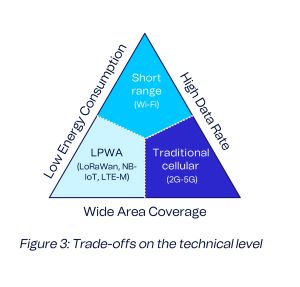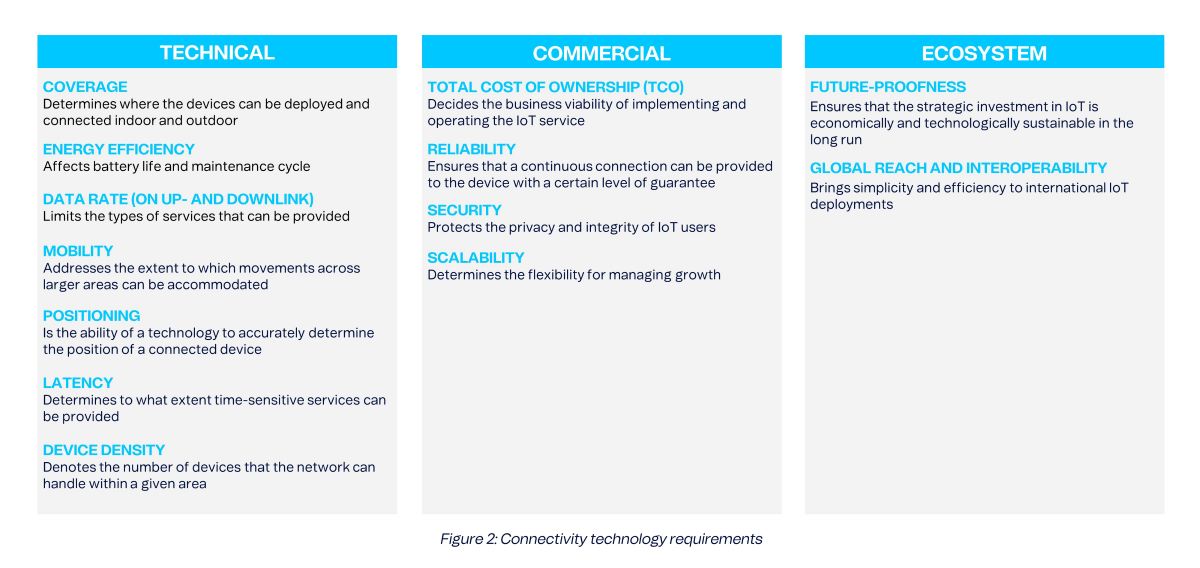Last updated: August 2025
IoT connectivity is what turns devices into connected solutions — enabling them to share data, deliver services, and create value. From sensors in a factory to self-driving cars on the road, connectivity is the foundation that makes IoT possible.
IoT connectivity is the means by which an IoT device — whether a simple sensor, a streetlight, or a robot — connects to the cloud, other devices, and integration points such as IoT gateways. Without connectivity, devices are just “things.”
2G/3G – Being retired in many regions.
4G / LTE Cat-1 – Standard cellular connectivity for IoT devices.
5G / 5G RedCap / 5G NSA – High-speed, low-latency IoT applications.
NB-IoT – Low-power, wide-area cellular network.
LTE-M – LPWAN over cellular for mobile IoT devices.
LoRaWAN – Long-range, low-power network for IoT sensors.
Sigfox – Declining LPWAN network, still used in some markets.
Wi-Fi – Local connectivity for high-throughput IoT devices.
Bluetooth Low Energy (BLE) – Short-range, low-power device communication.
ZigBee – Mesh networking for smart home and industrial IoT.
LEO / MEO / GEO satellites – IoT connectivity integrated with terrestrial networks.
Traditional cellular technologies’ strengths lie in data rate (mostly 4G, 5G) and range with complex designs optimized for mass consumer voice and data service; short range technologies like Bluetooth Low Energy (BLE) and ZigBee focus on data rate and battery life at the expense of connection range; LPWA technologies such as NB-IoT, provide superior battery life and coverage, but low data rate on the downside.
While there is no single technology that can excel in serving all use cases, several of the technologies have gained prominence in terms of technology maturity, ecosystem support and scale of commercial availability. For IoT deployments in wide areas or remote locations, LoRaWan, NB-IoT, LTE-M or LTE Cat 1 are good complements that address the needs of most use cases.
The various IoT technologies exhibit different strengths and weaknesses, depending on the technical, commercial and ecosystem angle, find out more on our page IoT Connectivity Comparison. This comparison illustrates the strengths and weaknesses of the major technologies.
| Technology | Coverage | Throughput | Latency | Energy efficiency | Global availability |
|---|---|---|---|---|---|
| NB-IoT | Very good (deep, indoor) | ~20 kbit/s | Poor | Very good | Available in most regions, adoption mostly in China |
| LTE-M | Very good | ~200 kbit/s+ | Good | Very good | Most EU & American markets; Australia |
| LTE Cat-1 / Cat-1 bis | Good | ~3 Mbit/s+ | Good | Good | Nearly universal |
| LTE Cat-4/4+ | Good | ~100 Mbit/s+ | Good | Poor | Nearly universal |
| 5G NSA | Good | ~300 Mbit/s+ | Very good | Poor | In most developed markets |
| 5G SA | Good | ~300 Mbit/s+ | Very good | Poor | Scaling in major APAC & US carriers |
| 5G RedCap | Good | ~10 Mbit/s+ | Very good | Very good | Early stages (US, China, Kuwait, Philippines) |
| Satellite (NTN) | Good in remote outdoor | ~10 kbit/s–1 Mbit/s+ | Poor | Solution dependent | Limited / trial markets |
Want a deeper dive into today’s IoT connectivity landscape? Our Buyer’s Guide explains what’s available now, what’s coming next, and how to make confident decisions.
The three main technical requirements for any enterprise looking into IoT connectivity technology are coverage, energy efficiency and data rate. No single technology can excel in all these aspects, as these are trade-offs every radio technology faces. In addition, organizations should consider where their IoT offerings will be provided. If you need global IoT connectivity you should adopt a connectivity technology that is available worldwide.
All IoT applications need good coverage to connect devices, but some need to cover only certain indoor areas while others require extensive coverage in rural or remote regions. A technology with long range is better suited to connect devices scattered in a wide area.
Traditional cellular technology, such as 3G or 4G are a typical example of a wide area solution with excellent outdoor device radio range in most urban areas. LPWA technologies further improve the connectivity range by employing more robust coding schemes, which makes them ideal for reaching remote areas and penetrating deep indoors. Short range technologies, such as Wi-Fi and ZigBee, are suitable for connecting many devices deployed in close vicinity.
The energy efficiency of a connectivity technology has a significant impact on the lifetime or the maintenance cycle of IoT devices relying on battery or energy harvesting and is dependent on range, topology, and complexity of the connectivity technology. The overall energy consumption of the device also depends on the usage of the application, such as the frequency and duration of message transmission.
Short range technologies like ZigBee rely on mesh topology to forward messages from one device to another over multiple hops. That way ZigBee can extend its coverage but may deplete batteries more quickly as an individual device must constantly listen and be ready to relay messages. Wide area technologies, such as 2G, rely instead on star topology and keep most of the intelligence and complexity at the base station where power supply is not a limiting factor. LPWA technologies, such as NB-IoT, further reduce the energy consumption by stripping down the signalling protocol and reducing the amount of overhead to the bare minimum, thus enabling longer battery life (up to 10 years).
Data rate requirements for IoT applications vary from hundreds of bit per second (bps) for metering to several megabits per second (Mbps) for video surveillance on the uplink. Furthermore, with the advent of more sophisticated IoT applications, end devices need to be able to receive data packages with sufficiently high speeds, i.e., have high enough downlink capabilities.
Wi-Fi and traditional cellular networks such as LTE have used large bandwidth and complex waveforms with adaptive modulation rate to support high data rate. But they either consume more power or have a shorter range. In contrast, most LPWA technologies, for example NB-IoT and LTE-M, have lower data rate and lower energy consumption as they employ a more robust modulation scheme and run on commodity-priced micro-controllers with limited bandwidth.

As illustrated, traditional cellular technologies’ strengths lie in data rate (mostly 4G, 5G) and range with complex designs optimised for mass consumer voice and data service. Short range technologies like Bluetooth Low Energy (BLE) and ZigBee focus on data rate and battery life at the expense of connection range; LPWA technologies such as NB-IoT, provide superior battery life and coverage, but low data rate on the downside.
In addition to the main technical considerations discussed above, there are other technical features that can be highly relevant for certain applications.
The more devices are connected, the more important it becomes for a connectivity technology to be able to handle large numbers of connections within a certain area. The challenge is to deliver reliable connectivity while minimising interference between the various signals. Typically, device density within the massive IoT context is considered in number of devices per square kilometre.
The fragmented nature of IoT deployments means organizations have many connectivity standards to choose from. Selecting the most suitable technology is a strategic decision, as it affects performance, cost, and scalability. Requirements vary by use case—some need high-speed, low-latency connections like 5G or 4G, while others benefit from simpler, low-speed connections that are more cost- and energy-efficient. Explore IoT use cases for different connectivity technologies to see which options work best in practice, and check out our IoT connectivity infographic for a visual overview of key choices.
